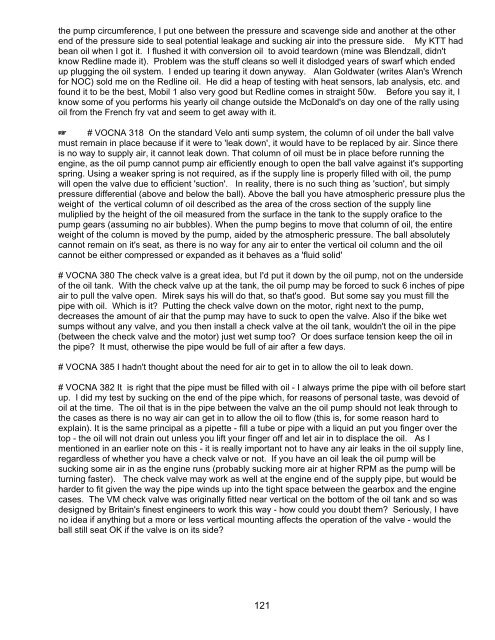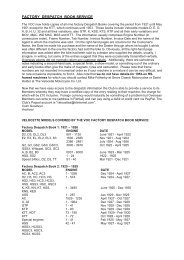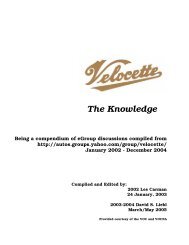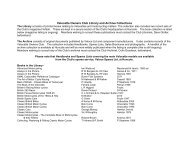The Knowledge - Velocette Owners Club
The Knowledge - Velocette Owners Club
The Knowledge - Velocette Owners Club
You also want an ePaper? Increase the reach of your titles
YUMPU automatically turns print PDFs into web optimized ePapers that Google loves.
the pump circumference, I put one between the pressure and scavenge side and another at the other<br />
end of the pressure side to seal potential leakage and sucking air into the pressure side. My KTT had<br />
bean oil when I got it. I flushed it with conversion oil to avoid teardown (mine was Blendzall, didn't<br />
know Redline made it). Problem was the stuff cleans so well it dislodged years of swarf which ended<br />
up plugging the oil system. I ended up tearing it down anyway. Alan Goldwater (writes Alan's Wrench<br />
for NOC) sold me on the Redline oil. He did a heap of testing with heat sensors, lab analysis, etc. and<br />
found it to be the best, Mobil 1 also very good but Redline comes in straight 50w. Before you say it, I<br />
know some of you performs his yearly oil change outside the McDonald's on day one of the rally using<br />
oil from the French fry vat and seem to get away with it.<br />
L # VOCNA 318 On the standard Velo anti sump system, the column of oil under the ball valve<br />
must remain in place because if it were to 'leak down', it would have to be replaced by air. Since there<br />
is no way to supply air, it cannot leak down. That column of oil must be in place before running the<br />
engine, as the oil pump cannot pump air efficiently enough to open the ball valve against it's supporting<br />
spring. Using a weaker spring is not required, as if the supply line is properly filled with oil, the pump<br />
will open the valve due to efficient 'suction'. In reality, there is no such thing as 'suction', but simply<br />
pressure differential (above and below the ball). Above the ball you have atmospheric pressure plus the<br />
weight of the vertical column of oil described as the area of the cross section of the supply line<br />
muliplied by the height of the oil measured from the surface in the tank to the supply orafice to the<br />
pump gears (assuming no air bubbles). When the pump begins to move that column of oil, the entire<br />
weight of the column is moved by the pump, aided by the atmospheric pressure. <strong>The</strong> ball absolutely<br />
cannot remain on it's seat, as there is no way for any air to enter the vertical oil column and the oil<br />
cannot be either compressed or expanded as it behaves as a 'fluid solid'<br />
# VOCNA 380 <strong>The</strong> check valve is a great idea, but I'd put it down by the oil pump, not on the underside<br />
of the oil tank. With the check valve up at the tank, the oil pump may be forced to suck 6 inches of pipe<br />
air to pull the valve open. Mirek says his will do that, so that's good. But some say you must fill the<br />
pipe with oil. Which is it? Putting the check valve down on the motor, right next to the pump,<br />
decreases the amount of air that the pump may have to suck to open the valve. Also if the bike wet<br />
sumps without any valve, and you then install a check valve at the oil tank, wouldn't the oil in the pipe<br />
(between the check valve and the motor) just wet sump too? Or does surface tension keep the oil in<br />
the pipe? It must, otherwise the pipe would be full of air after a few days.<br />
# VOCNA 385 I hadn't thought about the need for air to get in to allow the oil to leak down.<br />
# VOCNA 382 It is right that the pipe must be filled with oil - I always prime the pipe with oil before start<br />
up. I did my test by sucking on the end of the pipe which, for reasons of personal taste, was devoid of<br />
oil at the time. <strong>The</strong> oil that is in the pipe between the valve an the oil pump should not leak through to<br />
the cases as there is no way air can get in to allow the oil to flow (this is, for some reason hard to<br />
explain). It is the same principal as a pipette - fill a tube or pipe with a liquid an put you finger over the<br />
top - the oil will not drain out unless you lift your finger off and let air in to displace the oil. As I<br />
mentioned in an earlier note on this - it is really important not to have any air leaks in the oil supply line,<br />
regardless of whether you have a check valve or not. If you have an oil leak the oil pump will be<br />
sucking some air in as the engine runs (probably sucking more air at higher RPM as the pump will be<br />
turning faster). <strong>The</strong> check valve may work as well at the engine end of the supply pipe, but would be<br />
harder to fit given the way the pipe winds up into the tight space between the gearbox and the engine<br />
cases. <strong>The</strong> VM check valve was originally fitted near vertical on the bottom of the oil tank and so was<br />
designed by Britain's finest engineers to work this way - how could you doubt them? Seriously, I have<br />
no idea if anything but a more or less vertical mounting affects the operation of the valve - would the<br />
ball still seat OK if the valve is on its side?<br />
121





